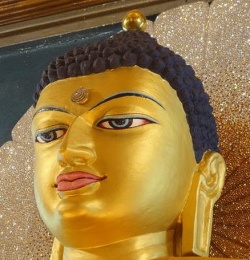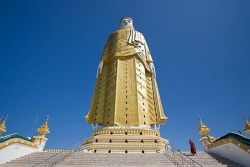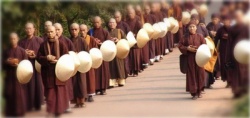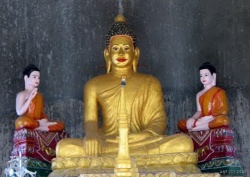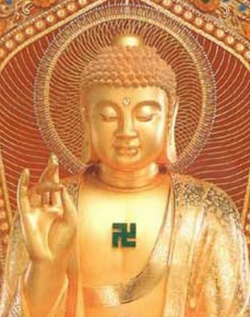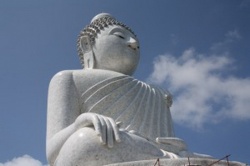Sankhara Essence
The word sankhara is like the word dhamma. It is used in so many ways and has so many different meanings.
The use of the word sankhara is at least fourfold:
(1) that which is put together;
(2) that which puts things together;
(3) the process by which things are put together; and
( 4) the activity of putting things together or creating things.
In the Pali phrase: "Sabbe sankhara anicca, sabbe sankhara dukkha", here sankhara means conditioned things or that which is put together. All things that are put together, that rely on causes and conditions for their existence are impermanent and unsatisfactory. In brief, sankhara here means 'thing'. It is a noun.
In the Pali phrase from the Dhammapada: "Sankharam paramam dukkha", or in the recollection about Nibbana: "the stilling of all formations (sankhara), the relinquishing of all acquisitions, the destruction of craving, dispassion, cessation, Nibbana", here sankhara means mental contocting, mental proliferating or mental activity.
In the Dhammapada, the Buddha states: "Sankharam paramam dukkha, Nibbana paramum sukkha", which means, mental construing is the supreme suffering and Nibbana is the supreme happiness. Usually, the translators say: "The aggregates are the supreme suffering" but from a Modern Theravada perspective, this translation is wrong. The translators incorrectly here have taken the word sankhara be a 'thing' rather than an 'activity'.
Of the five aggregates, there is sankhara khanda. Sankhara here refers to the mental capacity to concoct or construe. As SN 22.79 states:
"‘‘Kiñca , bhikkhave, saṅkhāre vadetha? Bhikkhus, why do they speak of sankhara?
Bhikkhus, this nature naturally concocts concocted things (abhisankharonti), for this reason it is called "sankhara." What does it concoct? It concocts rupa as something concocted with "formness," it concocts vedana as something concocted with "feelingness," it concocts sanya as something concocted with "recognition-ness," it concocts sankhara as something concocted with "concoctingness," it concocts vinyana as something concocted with "cognition-ness." Bhikkhus, this nature naturally concocts concocted things, for this reason it is called "sankhara."
Last, is the sankhara in dependent origination. Here sankhara means that which puts things together. These sankhara are explained in MN 9 & MN 44. If you read the writings of Nanavira, he quotes MN 9 and 44 just as I am to explain these sankharas.
From a Modern Theravada perspective, unlike the Classical Theravada view, these sankhara are simply the breathing in & breathing out; applied thought & sustained thought; and perception & feeling. In MN 9 and MN 44, these sankhara are called the kaya sankhara, the vaca sankhara and the citta sankhara, which mean the body fabricator, the verbal fabricator and the mind fabricator.
The breathing in & breathing out is the body fabricator because is conditions the state of the physical or flesh body. If the breathing is refined, smooth and long, the physical body will be relaxed and comfortable. If the breathing is short, agitated and coarse, the flesh body will be stressed and tight.
In the Anapanasati Sutta, the fourth step is called "calming the kaya sankhara", which simply means calming the breath. TheAnanapasati Sutta clearly shows the word kaya sankhara does not mean volitional bodily formations or kamma as the Classical Mahavirhara states.
For experiential understanding, when we meditate and can feel agitation in the breath, this agitation is ignorance conditioning the kaya sankhara. As Buddha taught: ignorance conditions sankhara, sankhara conditions consciousness. When the breath is agitated by ignorance, the conscious mind also is not clear.
Similarly, this agitated breath, agitated by ignorance, conditions the body-mind. Therefore, in our meditation, we observe this agitation of ignorance conditioning the breathing which conditions consciousness, mentality and the body. Similarly, when we calm the agitation in our breathing, we observe the nirodha of the agitation in the breathing and the freeing of the body and mind from dukkha.
The verbal fabricator or vaca sankhara conditions speech. Thinking occurs before speech occurs. Thus MN 44 states:
Why are directed thought & evaluation verbal fabricators?
Having first directed one's thoughts and made an evaluation, one then breaks out into speech. That's why directed thought & evaluation are verbal fabricators.
Similary, perception & feeling or the citta sankhara are the mind fabricator. From pleasant feeling comes lust, from unpleasant feeling comes hatred, from neither comes delusion. As MN 18 and SN 36.3 state:
With contact as a requisite condition, there is feeling. What one feels, one perceives (labels in the mind). What one perceives, one thinks about. What one thinks about, one complicates. Based on what a person complicates, the perceptions & categories of complication assail him/her with regard to past, present, & future forms cognizable via the eye.
If one feels joy, but knows not feeling's nature,
bent towards greed, he will not find deliverance.
If one feels pain, but knows not feeling's nature,
bent toward hate, he will not find deliverance.
And even neutral feeling which as peaceful
the Lord of Wisdom has proclaimed,
if, in attachment, he should cling to it,
he will not be free from the round of ill.
To end, the word sankhara is used in many ways. It means conditioned things, conditioning and conditioners. Or fabrications, fabricating and fabricators.
The Modern Theravada view is sankhara in dependent origination simply refers to the breathing in & out, applied thought & sustained thought and perception & feeling.
term "sankhara." This is a very common and important word in the Pali scriptures, but many people have problems with it due to its different uses and meanings. Languages are like that, uncertain and seemingly unreliable. The single word "sankhara" can mean "conditioner," the cause that conditions; it can mean "condition," the result of the action of conditioning; and it can mean "'conditioning," the activity or process of conditioning. We use the same word for the subject of the conditioning, "the concocter," as well as the object, "the concoction." We even use it for the activity, "the concocting," itself. This may be a bit confusing for you, so please remember that "sankhara" has three meanings. The correct meaning depends on the context. This knowledge will be valuable in your further studies.
Study the three meanings of sankhara in this body of ours. There is no need to study it in books or in a theoretical way. The body itself is a sankhara. It has been conditioned by a variety of causes and by the many things of which it is formed. Thus, it is a sankhara in the meaning of "condition." Once this body exists, it causes the arising of other things, such as thoughts, feelings, and actions. Without the body these thoughts and actions could never happen. Thus, it is a "conditioner" because it causes other actions. Lastly, in this flesh-body sankhara of ours, there is the process of conditioning going on constantly. We can discover all three aspects of the word sankhara within this very body. Study the meaning of sankhara in this comprehensive way. Then you will find it easy and convenient to realize more and more profound Dhamma as you go on.
In step three - "experiencing all bodies," experiencing both the breath and this flesh-body - each of these three meanings is practiced. First, we contemplate the flesh-body as the thing conditioned by the breath. Then, we see the breath as the conditioner of the flesh-body. Lastly, we observe the activity of conditioning that always exists simultaneously between the two of them. Thus, in the practice of step three we see the conditioner, the condition and the action of conditioning. This conditioning of the body is the physical level of sankhara. We have not yet seen it on the mental level. Step three is this work of seeing these three things together, simultaneously and continuously, within the mind. Then, you will see everything concerning the term "sankhara," especially as it relates to the kaya and its activity, right here in step three.
